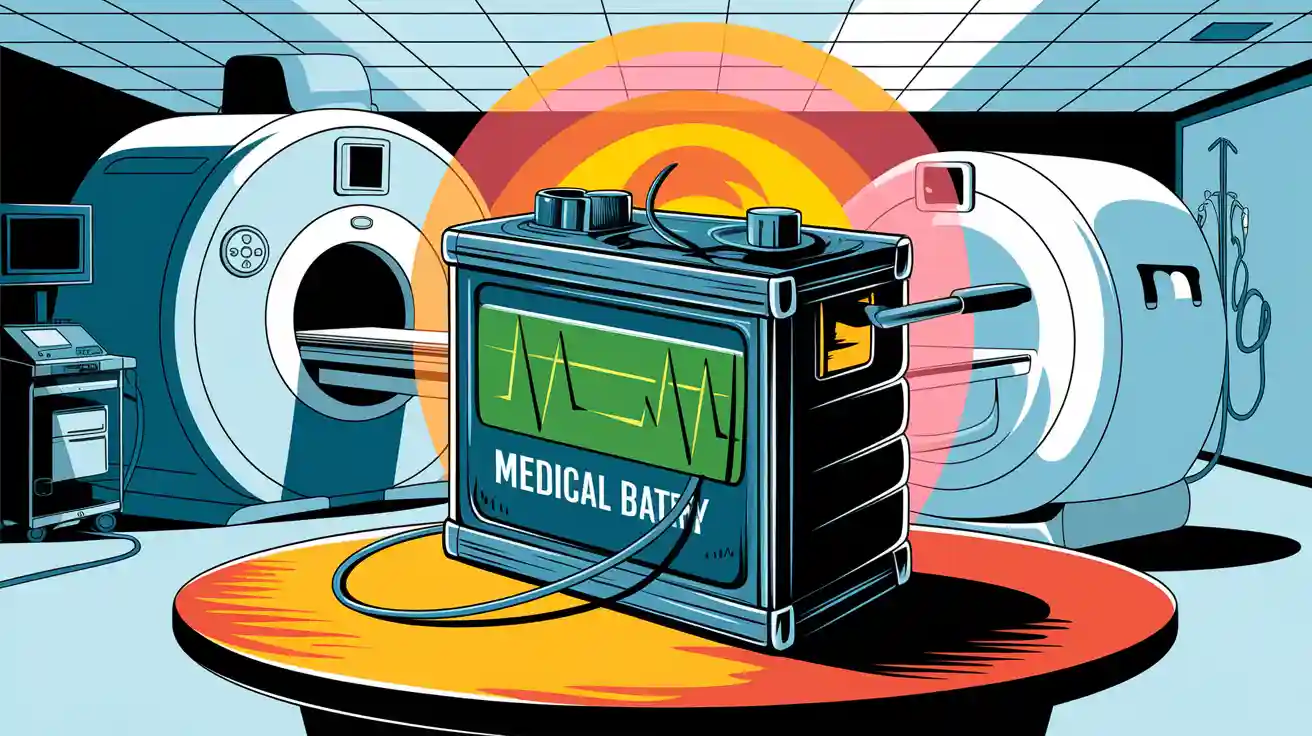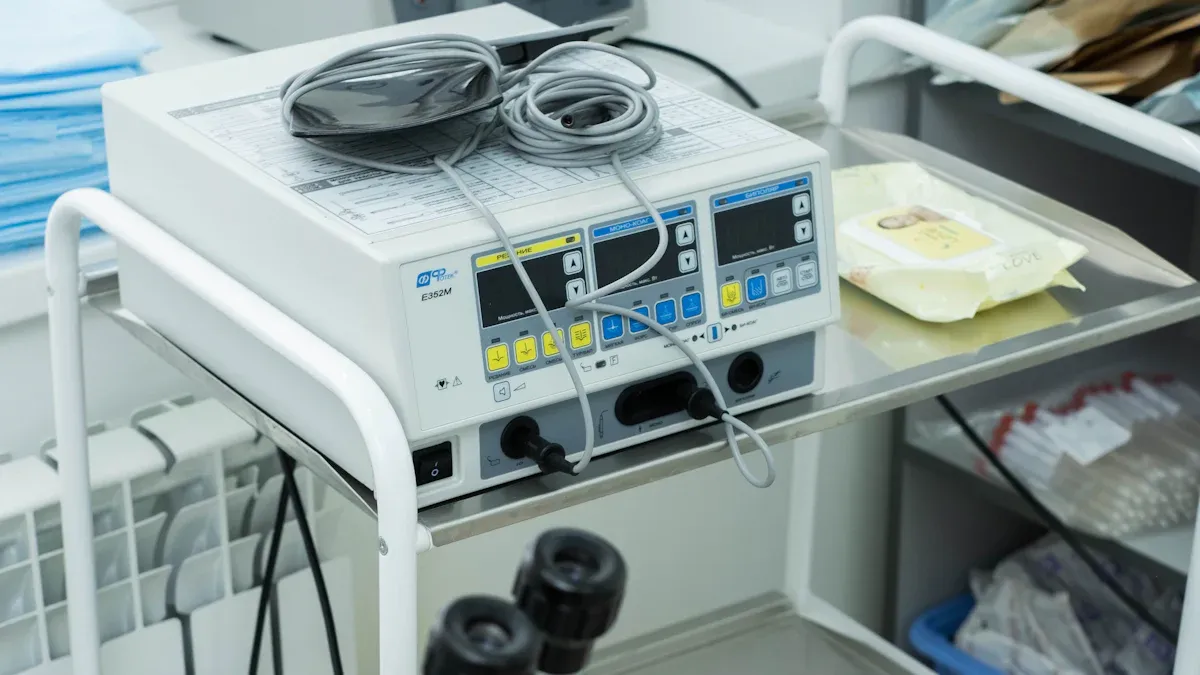
You face urgent challenges when protecting lithium battery packs from electromagnetic interference in MRI and X-ray rooms. Strong electromagnetic fields can trigger life-threatening interactions, especially during monitoring during MRI procedures. Device malfunction remains a top concern, with up to 50% of hospital issues linked to battery failures. The table below highlights the impact on patient safety:
Incident Description | Outcome | Recommendations |
|---|---|---|
Mobile phone use caused respirator malfunction | Patient death | Restrict mobile phone use in critical areas |
Mobile phone interference with syringe pump | Acute epinephrine poisoning | Maintain at least one meter distance from medical devices |
Non-magnetic lithium batteries with high EMC help you ensure reliable performance in critical care environments.
Key Takeaways
Use non-magnetic lithium batteries with high electromagnetic compatibility (EMC) to ensure reliable performance in MRI and X-ray rooms.
Implement physical shielding with non-magnetic materials to reduce RF noise and enhance patient safety during MRI examinations.
Follow strict regulatory standards, like IEC 60601-1-2, to ensure medical devices operate safely in electromagnetic environments.
Part 1: Electromagnetic Interference Risks
1.1 EMI Sources in MRI and X-Ray Rooms
You encounter electromagnetic interference from several sources in MRI and X-ray rooms. MRI technology uses a powerful static magnetic field, often between 0.5 and 3.0 Tesla. This field is about 30,000 times stronger than the Earth’s magnetic field. X-ray rooms, in contrast, do not generate magnetic fields but rely on radiation. The difference in operational principles means that MRI rooms pose a much higher risk of electromagnetic interference for sensitive equipment.
Source | Remedy |
|---|---|
Ensure proper shielding and check for leaks | |
Equipment within the scanner room | Turn off and unplug interfering equipment |
Deficiencies in RF shielding | Repair or replace damaged shielding elements |
You must address these sources to prevent device malfunction and ensure patient safety.
1.2 MRI Conditional Pacemakers and Battery Safety
MRI conditional pacemakers face unique challenges from electromagnetic interference. Manufacturers use nonferromagnetic materials like titanium and advanced filters to reduce risk. The latest models include:
Hall sensors for predictable behavior in magnetic fields
Enhanced circuit protection to prevent power supply disruption
Special filters to limit frequency transfer and dissipate energy
These features help prevent device malfunction during MRI scans. You should always verify that pacemakers meet MRI safety conditions, such as operation at 1.5 Tesla and specific SAR limits.
1.3 Impact on Lithium Battery Packs
Lithium battery packs in medical devices remain highly vulnerable to electromagnetic interference. Strong magnetic fields and RF energy can disrupt battery management systems, leading to device malfunction. You may see sudden shutdowns, errors, or even permanent damage to the battery pack. In critical care settings, this can put patient lives at risk. Non-magnetic lithium batteries with high electromagnetic compatibility (EMC) offer the best protection. You should always select battery packs designed for high EMC and non-magnetic environments to reduce the risk of device malfunction and ensure reliable operation in MRI and X-ray rooms.
Part 2: Protection Strategies and Compliance

2.1 Physical Shielding for Batteries
You must prioritize physical shielding as a core safety protocol for lithium battery packs in MRI examination environments. The use of non-magnetic materials in battery shielding plays a crucial role in reducing RF pickup and noise. This approach enhances MRI image quality and supports patient safety. Electrically floating non-magnetic batteries help mitigate potential interaction with the MRI system, minimizing the risk of RF noise emission.
Non-magnetic shielding materials:
Reduce RF pickup and noise, improving MRI image quality.
Lower the risk of potential interaction between the battery and MRI system.
Enhance patient safety by minimizing interference during MRI examination.
You should always select non-magnetic materials for battery enclosures and mounting hardware. This safety protocol ensures MRI compatibility and reduces the chance of negative interaction during MRI examination.
2.2 Grounding and Isolation
Proper grounding and isolation techniques form the backbone of any safety protocol in high-EMI medical environments. You need to implement optimized grounding strategies to prevent unwanted interaction and ensure MRI compatibility. The table below outlines recommended grounding techniques and their application contexts:
Technique | Description | Application Context |
|---|---|---|
Conductive shields | Made of conductive materials like copper, aluminum, or steel, creating a Faraday cage to block EMI. | High-level shielding effectiveness in medical contexts |
Absorptive shields | Made of materials that absorb EMI, converting it to heat energy. | Cost-effective for regular PCB applications |
Reflective shields | Made of high conductivity materials that reflect EMI away from sensitive electronics. | Effective at low and medium frequencies |
Single-point grounding | All circuits connected to a common ground point, suitable for low-frequency circuits. | Prevents common-mode impedance coupling |
Multi-point grounding | Each circuit grounded separately to the nearest ground plane, preferred for high-frequency circuits. | Reduces ground impedance for effective signal return |
Hybrid grounding | Combines single-point and multi-point techniques for optimal grounding. | Ensures effective grounding across various frequencies |
Floating ground | No coupling loop between circuits and ground, used to prevent ground loops. | Isolated power systems to avoid interference |
You should select the grounding method that best matches your device’s frequency range and installation context. This protocol helps you avoid potential interaction and ensures the safety protocol aligns with MRI examination requirements.
2.3 EMI Filtering Solutions
You must integrate advanced EMI filtering solutions as a critical safety protocol for lithium battery packs in MRI examination and X-ray environments. EMI/RFI filters are essential for meeting electromagnetic compatibility criteria and ensuring MRI compatibility.
EMI/RFI filters:
Operate in the frequency range of 150 KHz to 30 MHz, tailored for medical industry demands.
Provide up to 100 dB attenuation across 9 kHz to 10 GHz, supporting compliance with medical standards.
Offer minimal or zero leakage current, which is vital for patient safety and device longevity.
Medical device EMI filters differ from those used in other electronics. You must consider size constraints, low power consumption, and strict regulatory standards. Specialized filter designs, such as filtered feedthrough arrays or miniature capacitors, address these needs. Monolithic EMI filters have become common, providing superior noise suppression in compact designs. This trend reflects the growing need for MRI compatibility and effective interaction management in modern medical devices.
Tip: Always verify that your EMI filtering solutions meet the latest safety protocol and compatibility requirements for MRI examination. This step reduces the risk of potential interaction and supports ongoing patient safety.
2.4 Regulatory Standards and EMC
You must comply with strict regulatory standards to ensure the safety protocol for lithium battery packs in MRI examination and X-ray rooms. The IEC 60601-1-2 standard governs electromagnetic compatibility for medical batteries. The table below summarizes key aspects:
Aspect | Description |
|---|---|
Electromagnetic Immunity | Medical devices must function properly in the presence of electromagnetic interference, such as from cell phones. |
Electromagnetic Emissions | Medical devices must not emit electromagnetic interference that could affect other devices or systems. |
Requirements Specification | The standard outlines how manufacturers should test, document, and label devices regarding EMC compliance. |
Definition of EMC | The ability of medical equipment to operate satisfactorily in its electromagnetic environment without causing disturbances. |
Risk Management | Continuous updates to the risk management file are required to address risks from electromagnetic interference. |
The FDA also mandates rigorous testing to ensure lithium battery-powered medical devices do not interfere with other equipment. You must safeguard devices against external electromagnetic interference from sources like cell phones and hospital monitors. Failure to meet these requirements prohibits the sale of your device in the U.S.
You should follow best practices for design, installation, and ongoing maintenance:
Conduct thorough pre-procedural evaluations to understand the planned MRI examination.
Identify the medical device and document its battery status and settings.
Assess the patient’s dependency on the device and evaluate risks for arrhythmias during the procedure.
Estimate the likelihood of potential interaction and plan accordingly, including possible magnet application or device reprogramming.
Perform a follow-up on the device post-procedure to check for any signs of dysfunction or interaction.
Note: Advanced EMI protection strategies can increase costs due to high-grade materials, compliance testing, and environmental regulations. However, these investments are essential for maintaining a robust safety protocol and ensuring MRI compatibility.
Hospitals measure the effectiveness of EMI protection strategies by focusing on measurement accuracy, noise mitigation, and cell balancing. High measurement accuracy ensures reliable performance in noisy environments, which is critical for MRI examination and patient safety.
By following these safety measures and protocols, you can minimize the risk of potential interaction, ensure MRI compatibility, and protect patient safety during every MRI examination.
You protect lithium battery packs in MRI and X-ray rooms by using non-magnetic materials and meeting EMC standards. The table below shows the latest safe options for MRI conditional pacemakers, cardiac implantable electronic devices, and ICDs. You should work with manufacturers and monitor new technology for better pacemaker safety.
Material Type | MRI Safety Status | Notes |
|---|---|---|
Lithium-ion | MRI Conditional | Housed in aluminum or polymer casings. |
Lithium-polymer | MRI Safe | Non-magnetic materials used in construction. |
Aluminum | MRI Safe | Does not interfere with MRI magnets. |
FAQ
What makes lithium battery packs suitable for use in a magnetic resonance imaging room?
You need lithium battery packs with non-magnetic materials and high EMC. These features prevent interference in a magnetic resonance imaging room and support reliable operation for implantable and cardiac devices.
How do you ensure safety for implantable cardiac and deep brain stimulation devices in a magnetic resonance imaging environment?
You select MRI conditional devices with advanced shielding. These devices protect implantable cardiac and deep brain stimulation systems from strong fields in a magnetic resonance imaging environment.
Where can you find custom lithium battery solutions for magnetic resonance imaging and deep brain stimulation applications?
You can visit Large Power’s custom battery solution page for tailored lithium battery packs. These solutions support implantable, cardiac, and deep brain stimulation devices in a magnetic resonance imaging environment.






